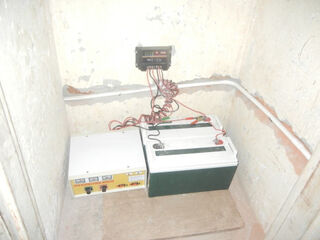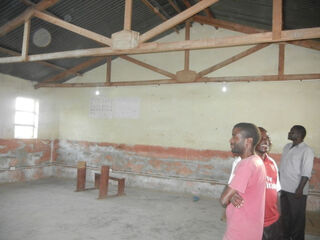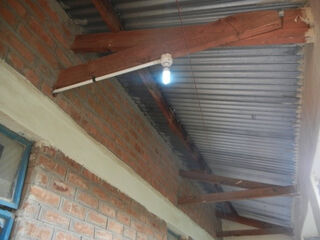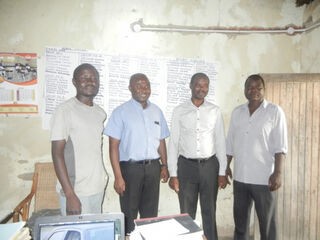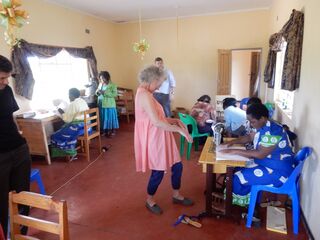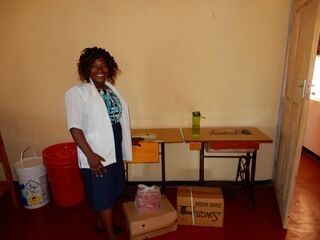Dear Friends of Bridges to Malawi,
Just wanted to thank you all for your generous donations. You gave us $6013 between Giving Tuesday and December 31, 2018!! Cindy and I were so inspired that we changed our minds and agreed to match many more of your contributions with our own money. We were ultimately able to match $5350, doubling almost all of your impact. Thanks again, hope your holiday season was wonderful, and have a great 2019! Brian Lisse, MD, (President, Bridges to Malawi) and Cindy DeRuyter, RN, (Brian’s wife and fellow board member).
January 2, 2019: Happy New Year to all! Congratulations to Olivia Rainville, the 2018 high school contest winner. She will be traveling for free with our annual Bridges to Malawi medical mission trip in April of 2019. She will be accompanied by 12 other high school students, who will be paying their own way. A 24 person team of healthcare providers and computer experts will also be going. This the largest group we’ve ever had and includes many people new to the organization. We’re very excited to have them all along with us!
October 18, 2018: The Annual Bridges to Malawi High School Contest lectures and test will be held at the First United Methodist Church in Hudson, MA. First set of lectures 6PM-9PM Saturday November 3, 2018. Second set of lectures and test will be held 6pm-10pm on Saturday November 10, 2018. Nonrefundable registration fee of $75 is due on Nov 3. Students eligible for this contest include high school Juniors and Seniors from Marlboro, Hudson, Nashoba Regional, and Ayer-Shirley Regional HS, UNLESS you have already been given permission to take the test by Dr. Hangen or Dr. Lisse.
Trip report from April 7-22, 2018:
The 2018 Bridges to Malawi trip lasted from April 7-22, 2018. The group in total consisted of 6 high schools students (Halle Hangen, Samantha McLaughlin (this year’s contest winner), Jessica Gordon, Maddie Edwards, Herzen Reis, and Gabriella Oliviera); Drs. Brian Lisse, Don Hangen, Lalita Matta, and John Lozada; Jennifer Hardy (IT teacher); Naomi Lisse, Maggie Del Ponte and Gail Benkover (chemical engineers); Louis Cote( English teacher); Jennifer Mehigan, NP; Andrew Gibson, EMT; Ellie von Wellsheim, Kelly de La Rocha, and Lori Ludlow of the Mooncatcher Project.
We arrived in Malawi and went straight to Mtunthama, arriving on April 8th. The next 24 hours were spent in travel recovery, orientation to the Mthunthama Anglican compound (living quarters, St. Andrews Hospital, Orphanage, primary and secondary schools, and the church. I purchased a polaroid camera prior to travel to Malawi; it proved a huge hit with the orphans as well as with the moms of sick kids at St. Andrews Hospital and at our outreach clinics. As usual, our high school students took an instant liking to the orphans, picking them up, hugging them and having to be persuaded to eventually put them back down again.
St. Andrews was full when we first arrived, with patients sleeping on mattresses on the floors in many places. Many of the patients were ill with malaria, dehydration, malnutrition, or pneumonia. Fortunatley this year, all the patients recovered; there were no deaths. We also met Karen Brokke, a Dutch medical student who had been working at St. Andrews for several weeks prior to our arrival. She proved to be quit inspirational, setting up a go-fund me page to replace hole- filled mosquito nets in the hospital and provide them as well for the St. Andrews’ family member “hostel” and the “antenatal unit.” In addition she storve to raise money for window screens for the hospital as well as for mattresses for women with high risk pregnancies sleeping till then on the floor of St. Andrews’ “antenatal building.” We took up a collection and provided her with over $700 to help accomplish this. Within a week, the screens were up on all the hospital ward window and we had helped place all of the new mosquito nets and mattresses.
As usual, many of our team members donated blood, including me. It’s always so gratifying to watch your blood being transfused into some critically ill person, especially if it saves their life! We also spent a lot of time aggressively treating a child very sick with asthma, and it was wonderful to see his breathing improve over the next few hours. He went home a few days later, completely back to normal.
We were asked to help interpret the ultrasound of the abdomen of a patient who had appeared to have a mass. The ultrasound was felt to be consistent, unfortunately, with metastatic cancer of the gallbladder. At least we could tell the patient what was wrong and give him a chance to get his affairs in order. So sad. There is almost no cancer care in the entire country; certainly none in Mtunthama.
I was shown the book used to list all the ultrasounds done since we donated the machine in 2014. The book must have had over 2000 names in it. I also noted that Peter Minjale and his fellow CMO’s have significantly expanded their proficiency in ultrasound; they don’t use it just for OB-Gyn concerns, which was the case when they first got the machine. This is particularly important in a setting where there is no other means of radiology imaging available.
One day when we were making rounds in the post-operative ward at St. Andrews, a relative of a patient asked to speak to me. She wanted to express her profound gratitude for the indoor residual spraying we were doing in the area where she lived. She told us that there was, as a result, no malaria in that area, and that her daughter, who had worked as one of our spray operators. Made enough money by doing this to pay for 2 years of school fees as a result, thus enabling her to greatly advance her education!
Because of the difference in our skill sets, Don Hangen our orthopedist spent most of his days at Kasungu District Hospital (KDH), often performing operations on patients who could not be helped until he came back to Malawi. Drs. John Lozada and Lalita Matta as well as Jenn Mehigan, Pediatric NP, spent much time working at St. Andrews , but also had a chance to go to KDH and try to help out. I spent my inpatient clinical time working exclusively at St. Andrews. All of us healthcare providers had an opportunity to be involved in rural outreach clinics which were held in 3 different villages on different days. We saw about 1,000 patients overall doing this, diagnosing and treating much malaria, but many other significant illnesses as well, sending about 10 patients to the hospital for further treatment and work-up.
Over the 2 weeks of our trip, we also toured various sites of BTM development work. Because of time limits, it was impossible for us to see everything we were doing, but it was great to have a taste of the level of our success! We saw an earthen dam being constructed by Land Lease farmers to help irrigate their crops. In this same village, we held a rural outreach clinic as well. As well on this day, Peter pointed out a farmwoman who had benefited from our goat pass-on program, explaining that she had gone from 1 goat to 6, and that, once she sold 5 of her goats, she would make enough money to send 2 of her children to secondary school (this can’t happen unless one can afford school fees and textbooks and uniforms). In another village a few days later, we met a group of about 40 farmers who had benefitted from our programs. When asked how many had received goats from us, all the hands went up, while about 2/3 raised their hands when asked if they had received a micro-credit loan from us and started their own business.
During much of our stay, our tech team, led by Jennifer Hardy and Naomi Lisse, spent an entire day at village after village participating in laptop donation ceremonies and then teaching faculty, parents, chiefs, PTA, school board members, and high school students how to type and use a laptop. In the 4 villages where this occurred, only about 4 of the 400 some students had ever seen a computer or had a chance to work with one. Peter and I participate in the ceremonies as well, but then went back to the hospital to work clinically. The headmasters of the school s took particular delight in showing off the lit bulbs from the solar power systems we had donated. Peter had arranged a K2TASO comedy team to help introduce the idea of solar power and laptops to the community (when Peter said we were stopping at Wimbe to pick up the comedians, I was sure I had misunderstood his English). It turned out that this group was using ancient technique (dating to at least the Greek around 400BC) to educate and sing the praises of our 21st century technology. The skits they performed were outside under the shade of a large tree at each of the schools we had helped. This made the whole experience even more magical. As if this weren’t enough, part of the ceremony included celebratory singing and traditional dancing by the students. In our speeches we emphasized how the solar lighting would enable students to study at night, which, among other things, will help improve their national test scores and thus give them more chances for future educational opportunities. We also emphasized the extraordinary amount of educational materials in the laptops, which are filled with Khan Academy, among other software. This includes most of literature in the English language, videos on biology, physics, chemistry, and other sciences, encyclopedic references, and information on modern agriculture practices, including conservation agriculture. In short, we told these students we were giving them a chance at a better future, a means to break the multi-generational cycle of subsistence farming and consequent persistent and predicable poverty by giving them a chance to farm better or learn skills useful in the city and likely to provide for a regular job and better income.
We also initiated a girl’s empowerment curriculum, working closely with our Malawi colleagues. We showed the movie, “Queen of Katwe” as a way of starting the conversation about gender equality since it’s the story of a poor African girl who becomes a chess master, easily beating her male competitors. This generated lots of discussion and interest. The best comment I heard was that of a male teenager playing chess with another male teenager right after we showed the movie. He said, referring to his competition, “he’s our male Fiona,” referring to the heroine of the movie. In other words, he had taken the message to heart and was using the female character as the ideal to be compared to! We gave copies of the movie to each school we worked at while we worked with the local educators to continue the process of empowering girls further. We also donated chess sets as part of this process, assuming, rightly so, that the movie would generate much interest in learning the game.
As part of our development visits, we also went to a village where over 2500 BTM donated tree saplings had been planted and were being cared for in the hopes that a “forest” would result. The farmers in our area understand about the ills of deforestation and the consequences of global warming. They are interested in planting thousands more trees if possible. It was wonderful to meet these people and experience the depth of their dedication to eloping to reverse climate change.
Since we were last at the K2TASO secretariat, we noted several changes. First, Cindy’s House, the grain storage facility we had constructed is now filled with grain as well as the “mouse mitigation project” (i.e., a cat to keep our grain safe). Other parts of this building were being used by K2TASO for open air palliative care counseling sessions and also for the mooncatcher project (Ellie von Wellsheim, who runs the project, came with us again this year in order to do quality control and enhance the current program). In addition, the corn field surrounding the secretariat had been replaced by approximately 1500 trees of all kinds, including ones that will provide among other fruits, oranges, guava, and papaya to the poor beneficiaries of K2TASO’s work. There is a plan to plant another 1000 trees or more here. These trees were all provided by funding from BTM and are a part of our reforestation program. Always great to see our plans coming to fruition (pun intended!)
We left and returned home safely an exhausted from all of our hard work on April 22, 2018. All in all it was a wonderful trip, as always, filled with many incredible and inspiring moments. It was particularly wonderful to see how effective all of our work seems to be. Always inspirational to work closely with Peter Minjale and his tireless K2TASO colleagues. And always sobering to see how much more needs to be done. Brian Lisse, MD
From Peter Minjale, CMO, head of K2TASO, our Malawian sister organization:

